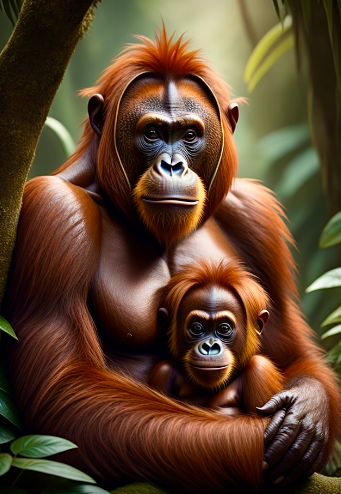Introduction to Baby Orangutans
Baby orangutan are one of the most adorable creatures on the planet. With their big, curious eyes and fluffy red fur, these little primates capture hearts everywhere. But beyond their cuteness lies a deeper story—a tale filled with challenges that threaten their very existence. As we delve into the world of baby orangutans, we uncover not just their charm but also the urgent need for wildlife conservation efforts surrounding them. Understanding these young apes opens our eyes to both the beauty and fragility of nature itself. Let’s explore what makes baby orangutans so special and why they deserve our attention now more than ever.
Threats to their Survival
Baby orangutans face numerous threats that endanger their survival. One of the primary challenges is habitat loss. Deforestation, driven by palm oil plantations and logging, strips away their natural home.
Moreover, illegal wildlife trade poses a significant risk. Young orangutans are often taken from the wild to be sold as pets or for entertainment purposes. This not only disrupts populations but also leaves mothers vulnerable and unable to care for their young.
Climate change further complicates matters. Rising temperatures and changing rainfall patterns affect food availability in forests where these primates thrive.
Additionally, human-wildlife conflict occurs when orangutans venture into agricultural areas searching for food. Farmers sometimes resort to lethal measures to protect their crops, leading to tragic outcomes.
Together, these factors create a precarious situation for baby orangutans as they fight against extinction in an increasingly hostile environment.
Efforts Towards Conservation
Conservation efforts for baby orangutans are gaining momentum across the globe. Organizations partner with local communities to protect their habitats, focusing on sustainable practices that minimize deforestation.
Education plays a vital role in these initiatives. Raising awareness about the plight of orangutans helps foster a sense of responsibility among people. Workshops and community programs showcase how everyone can contribute.
Reforestation projects also make a significant impact. Planting native trees creates safe havens for these young primates and restores ecosystems damaged by logging and agriculture.
Additionally, strict anti-poaching measures are enforced to safeguard existing populations. Laws are tightened, ensuring that those who harm orangutans face severe penalties.
Collaborations between governments, NGOs, and private sectors further amplify conservation strategies. By pooling resources and expertise, they work toward creating more effective solutions for preserving these incredible creatures.
The Role of Sanctuaries and Rehabilitation Centers
Sanctuaries and rehabilitation centers play a crucial role in the survival of baby orangutans. These safe havens provide essential care for young orphans who have lost their mothers due to deforestation or illegal wildlife trade.
Expert teams at these facilities focus on medical treatment, nutrition, and socialization. They create environments that mimic natural habitats, allowing the babies to thrive as they learn vital skills.
Education is another key component. Staff members often engage with local communities to raise awareness about orangutan conservation. This helps reduce human-wildlife conflict while fostering support for preservation efforts.
As these centers work tirelessly to rehabilitate baby orangutans, they also contribute valuable knowledge for future conservation strategies. Their dedication ensures that these incredible creatures can be reintroduced into the wild when they are ready, giving them a second chance at life in their natural habitat.
The Success Stories of Rescued Orangutans
Across the world, rescued orangutans have shown remarkable resilience. Each story is a testament to their strength and adaptability.
Take the journey of Bella, for instance. After being orphaned due to deforestation, she was brought to a sanctuary where caregivers provided her with love and care. With time, Bella learned vital skills necessary for survival in the wild.
Then there’s Joko, who faced severe malnutrition as a young infant. His transformation at a rehabilitation center was nothing short of miraculous. He went from frail and weak to thriving under expert guidance.
These success stories highlight not only individual growth but also the larger impact of conservation efforts. Every rescued baby orangutan carries hope for their species’ future. As they return to their natural habitats, these animals inspire us all with tales of recovery against overwhelming odds.
How Individuals Can Help
Supporting the conservation of baby orangutans can start with small actions. Consider adopting a baby orangutan through reputable organizations. Your contribution helps fund their care and rehabilitation.
Educating others about the plight of these adorable creatures is equally important. Share information on social media or organize awareness events in your community. The more people know, the stronger the support for conservation efforts.
Volunteering at local wildlife sanctuaries can make a direct impact, too. Many facilities welcome help from those passionate about animal welfare.
Additionally, consider making eco-friendly choices in your everyday life. Reducing palm oil consumption protects habitats critical for orangutans’ survival.
Donations to trusted wildlife organizations play a vital role in funding rescue operations and habitat restoration projects dedicated to saving these incredible animals from extinction.
Conclusion
The plight of baby orangutans serves as a poignant reminder of the fragility of our natural world. These charming creatures, often seen swinging from tree branches or cuddling their caregivers, symbolize both innocence and the urgent need for conservation efforts.
Their survival is threatened by habitat loss, poaching, and illegal pet trade. Every year, countless baby orangutans are orphaned due to deforestation caused by palm oil plantations and logging activities. This destruction not only endangers their lives but also disrupts entire ecosystems.
Fortunately, dedicated individuals and organizations are working tirelessly toward conservation. They focus on protecting habitats through legal measures while raising awareness about sustainable practices that benefit both wildlife and local communities.
Sanctuaries play a critical role in the rehabilitation of these young animals. Facilities like the Orangutan Foundation International work to ensure that rescued babies receive proper care before being reintroduced into their natural habitats. These centers provide essential medical attention and foster an environment for social learning among peers.
Success stories abound—tales of resilient rescued orangutans returning to the wild after years in captivity inspire hope. Each successful release brings us one step closer to stabilizing populations that have been pushed towards extinction.
Individuals can make a significant impact too! Supporting reputable organizations through donations or volunteering helps fund vital rescue operations and ongoing education programs aimed at preserving these amazing animals’ futures. Even simple actions such as choosing sustainable products can contribute positively toward conserving their habitats.
Every effort counts when it comes to protecting baby orangutan for future generations. By raising awareness about their struggles alongside celebrating victories in conservation, we can all be part of this crucial mission.


